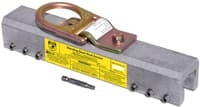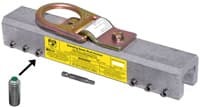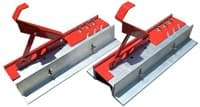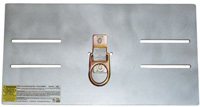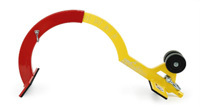Fall Protection For MetalMax Standing Seam Panels
Posted by Howie Scarboro - CEO Fall Protection Distributors, LLC on Apr 17th 2025
See the Roof Anchor Compatibility Chart for MetalMax Roofing Roofing Standing Seam Panels.
Who Is MetalMax Roofing and Siding?
MetalMax Roofing and Siding is a family-owned manufacturer based in Murfreesboro, Tennessee, that's been delivering high-quality metal roofing and siding solutions since 2010. What began as a local business has grown into a trusted name nationwide, now operating additional facilities in Texarkana, Texas; Hermiston, Oregon; Concord, New Hampshire; and Calhoun, Georgia—their reputation centers on producing durable, eco-friendly products that balance innovation with old-fashioned customer care.
The crown jewel of MetalMax's lineup is their standing seam metal roofing, which is well-known throughout the industry for its reliability and style. These roofs are crafted from continuous steel or aluminum panels, running from ridge to eave, and connected by raised interlocking seams that keep out water and weather. Engineered to handle Tennessee's unpredictable climate—heavy summer storms, winter ice, or sweltering heat—MetalMax panels have protection from advanced coatings that fight corrosion, fading, and UV damage. Backed by a 40-year warranty, these roofs stand the test of time.
Homeowners, builders, and architects have plenty to choose from: snaplock profiles for faster installs, mechanically seamed panels for extra strength in high-wind areas, and even bold batten seam options for projects where looks matter just as much as performance. MetalMax also offers a wide array of colors, panel widths, and thicknesses—making it easy to match any design, whether a rural barn or a modern home. The panels' reflective finishes add energy efficiency, keeping cooling costs in check during hot Tennessee summers, while the recyclable materials support sustainability.
As a family business, MetalMax maintains hands-on control at every production stage in its Murfreesboro facility. It uses state-of-the-art equipment to ensure quality, offers fast lead times, and provides personalized technical support to customers and contractors. This level of service sets it apart in a crowded industry.
For anyone seeking a rugged and attractive roof—built by a company with deep local roots—MetalMax standing seam roofing offers decades of peace of mind, energy savings, and curb appeal.
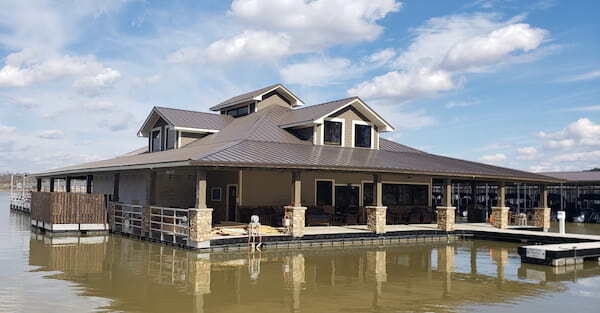
Why Compatible Fall Protection Is Essential for MetalMax Standing Seam Roofs
Standing seam metal roofs from MetalMax feature longevity and a modern look—they're also a favorite because of how workers install them. With hidden fasteners and raised seams, these roofs create a weathertight barrier that handles the most challenging conditions.
Why? Drilling holes or using the wrong anchors can destroy a roof's watertight seal, void warranties, and open the door to rust leaks and costly damage. That's why using non-penetrating fall protection systems engineered for standing seam profiles is critical. These anchors clamp directly onto the seam—without a single hole—so the panel's integrity stays intact.
But there's a catch: MetalMax offers several panel styles, each with its own seam shape and material thickness. Not every anchor fits every seam, and using the wrong product can be dangerous and damaging. That's why choosing fall protection equipment compatible with the exact MetalMax panel you're working on isn't just best practice—it's essential for OSHA compliance and long-term roof performance.
Some of the top solutions include the SSRA1 Seam Anchor, which uses non-penetrating set screws to create a secure tie-off point, and the SSRA2 Adjustable Roof Jack Adapter and SSRA3 Anchor Plate for walkboards and horizontal lifeline systems. For seam shapes or substrates where clamp-on anchors aren't an option—such as thin gauge steel or batten seam panels—the Ridge Pro Steep Assist Anchor provides a secure anchor point at the ridge, making it a strong alternative for roofs with a 6/12 to 12/12 pitch.
The bottom line: Matching your fall protection gear to your MetalMax panel isn't just about ticking a safety box—it's about protecting your crew, your client's investment, and the roof itself for decades.
MaxLoc Snaplock Panels

The MaxLoc panel is one of MetalMax's most popular standing seam options. Thanks to its concealed fastener leg, it offers a clean look and a weathertight seal. Once installed, each panel covers 16 inches of roof surface, and the seam height measures 7/8 of an inch—low enough to create a streamlined appearance but still tall enough to keep out water. It's a versatile design that balances aesthetics and performance across various projects. See the Roof Anchor Compatibility Chart for MaxLoc Snaplock Roofing Standing Seam Panels.
MaxLoc panels are ideal for residential homes, commercial properties, and agricultural buildings throughout Tennessee and beyond. Their concealed clip system attaches over solid substrates like plywood or OSB, giving the roof structure a firm foundation while allowing for thermal expansion—essential in climates that swing from humid summers to icy winters. Whether you're working on a modern home, a high-traffic office, or a barn full of valuable equipment, MaxLoc panels are durable and require minimal upkeep.
The panels are available in 26-gauge and 24-gauge steel. The lighter 26-gauge panels are budget-friendly and well-suited for residential or light commercial work. For more demanding jobs, 24-gauge steel increases strength, especially in areas prone to wind or heavy snow. Both gauge options come coated in energy-efficient finishes like Kynar 500 or Hylar 5000 PVDF, which help reflect heat, resist fading, and extend the panel's lifespan. A Galvalume base layer adds rust protection, and the 40-year finish warranty offers long-term peace of mind.
With various colors available—including options like Rustic Red, Charcoal, Ocean Blue, and Copper Metallic—MaxLoc panels work with almost any architectural style. Compared to MetalMax's higher-end MaxSeam panel, which features a 1 ¾-inch rib and narrower 14-inch coverage, the MaxLoc stands out for its cost-efficiency and ease of installation.
Manufactured in-house at MetalMax's Murfreesboro facility, MaxLoc panels benefit from consistent quality control and fast turnaround times. Contractors can rely on detailed installation guides, matched accessories, and dedicated technical support to ensure long-term success on every job.
Fall Protection for MaxLoc Panels
When working on MaxLoc roofs made from 24 gauge steel, contractors can access a full lineup of non-penetrating fall protection systems that preserve the panel's integrity. The SSRA1 Seam Anchor clamps directly onto the standing seam without drilling, offering a secure tie-off point for lifelines or personal fall arrest systems. Each anchor attaches with six pairs of set screws, providing a grip firm enough to meet or exceed OSHA requirements without compromising the roof's watertight design.
The SSRA2 Adjustable Roof Jack Adapters mount to the SSRA1 anchors to create stable working platforms across the roof surface. These adapters accept standard 10-foot wooden walkboards, giving workers a secure, elevated path while installing panels or performing repairs. When crews need a multi-worker setup, the SSRA3 Anchor Plate is installed on top of two SSRA1 Anchors, forming a solid base for a 100-foot temporary horizontal lifeline system. This setup supports multiple tie-off points and is ideal for long runs on steep or slippery surfaces.
While these three components work in harmony for 24 gauge steel MaxLoc panels, it's important to note that some snaplock seams may vary slightly in shape. Workers are encouraged to perform a test fit to ensure a compatible fitment.
For all other substrates—such as 26 gauge steel, aluminum, or Galvalume, where clamp-on anchoring may not hold securely—the Ridge Pro Steep Assist Anchor is the better option. This anchor hooks over the roof's peak and offers a secure connection point for a vertical lifeline on 6/12 to 12/12 roofs. It allows workers to remain tied off from leaving the ladder until they descend, meeting the most stringent fall protection requirements.
By matching the proper fall protection to the panel type and substrate, contractors stay compliant and protect the integrity of the roof and their crew's safety. On MaxLoc panels, the right gear makes all the difference.
MaxSeam Snaplock Panels

MaxSeam panels are a premium standing seam roofing option used in everything from residential homes to large-scale commercial buildings and agricultural projects. Built for strength and visual appeal, these panels thrive in regions like Tennessee, where the weather can swing from humid summer storms to icy winter fronts. Their tall, pronounced seams enhance aesthetics and protect against water infiltration and high winds. See the Roof Anchor Compatibility Chart for MaxSeam Snaplock Roofing Standing Seam Panels.
Installed over a solid substrate such as plywood or OSB, MaxSeam panels use a concealed clip system that allows for natural expansion and contraction as temperatures shift. This feature makes them exceptionally reliable in climates with dramatic seasonal changes. While primarily installed on roofs, some projects use MaxSeam as vertical siding for a bold, architectural finish, though this is less common.
MaxSeam panels are available in both 26-gauge and 24-gauge steel. The 26-gauge version is cost-effective and works well for residential or light commercial jobs. The thicker 24-gauge steel is ideal for areas exposed to high winds or heavy snow loads, offering superior durability and a longer lifespan. Both gauges come with corrosion-resistant Galvalume coating and high-performance PVDF coatings like Kynar 500 or Hylar 5000. These finishes enhance energy efficiency, reduce fading, and hold up well under intense sun exposure. Color options are extensive and include everything from classic tones like Polar White and Rustic Red to modern selections like Charcoal and Copper Metallic.
What sets the MaxSeam apart is its mechanical seaming option. Unlike snaplock panels that interlock, the MaxSeam edges crimp together using a mechanical seamer, forming either a 90-degree single lock or a 180-degree double lock seam. This process creates a nearly impenetrable seal, perfect for commercial buildings, high-wind zones, or snow-loaded areas. While this method does add labor to the installation process, it delivers unmatched performance and longevity.
Compared to the MaxLoc, the MaxSeam is a more refined, high-end product. The 14-inch coverage width and 1 ¾-inch seam height give it a sharper, dimensional profile that's less susceptible to oil canning and more suitable for curb appeal-driven projects. While it comes at a higher price point, it's a worthwhile upgrade for jobs that demand top-tier aesthetics and performance. MetalMax manufactures these panels in-house at their Murfreesboro location, ensuring tight quality control and fast lead times with every order.
Whether for a commercial office, a modern farmhouse, or a tough agricultural building, the MaxSeam stands up to the elements and adds long-term value through strength, beauty, and low maintenance. It's also compatible with solar systems. It pairs well with MetalMax's trim and ventilation accessories, including Snap Z vented closures for proper airflow beneath the panels.
Fall Protection for MaxSeam Snaplock Panels
When working on MaxSeam roofs made from 24 gauge steel, fall protection must match the roof's structural design without compromising its integrity. The SSRA1 Seam Anchor is a non-penetrating solution that attaches securely to the raised seam using a set screw system. Once installed, it provides a tie-off point that complies with OSHA's 5,000-pound load requirement—all without drilling a single hole.
SSRA2 Adjustable Roof Jack Adapters can be mounted directly onto the SSRA1 Anchors to create safe walkways across the roof. These adapters hold standard 10-foot walk boards, offering workers a stable platform on even the steepest standing seam surfaces. When running a multi-user system, the SSRA3 Anchor Plate mounts to a pair of SSRA1 Anchors. It is the foundation for a temporary horizontal lifeline up to 100 feet long. This setup is ideal for large commercial roofs or extended runs that require continuous fall protection for multiple workers.
While the SSRA product line works seamlessly with 24 gauge MaxSeam panels, performing a test fit before beginning installation is always a good idea. Some snaplock seam geometries may vary slightly from batch to batch or region to region, and confirming compatibility upfront can prevent surprises later.
For all other substrates—like 26-gauge steel or aluminum panels—the Ridge Pro Steep Assist Anchor is the recommended alternative. This anchor hooks securely over the ridge of the roof and allows the user to maintain continuous tie-off with a vertical lifeline, making it a strong choice for steep-slope roofs between 6/12 and 12/12 pitch. Because it mounts at the peak rather than the seam, the Ridge Pro avoids issues with panel thickness or seam shape while still delivering reliable fall protection.
Choosing the right anchoring method for MaxSeam panels ensures a safer worksite, preserves the roof's warranty, and eliminates the risk of damaging a premium roofing system during installation or repair.
Standing Seam Metal Roof Anchor Panel Compatibility Chart For MetalMax Roofing
| MaxLoc Panel 24 ga. |
MaxSeam 24 ga. |
|
|---|---|---|
| YES | YES | |
| YES | YES | |
| YES | YES | |
| YES | YES | |
| YES | YES |
Contact Us For More Information
For further details on roofing solutions and fall protection systems, contact us at 863-703-4522 or www.StandingSeamRoofAnchor.com. Let's work together to make your roofing projects safe, beautiful, and built to last. For more safety tips, check out OSHA's 48-page fall protection manual. Once you have determined the most suitable anchors for your roof system, download our free Anchor Inspection Form.
Safety Tips For Standing Seam Roofs
Prioritize Ladder Safety Training
The most dangerous part of the job sometimes happens before anyone sets foot on the roof. Improper ladder use causes countless preventable injuries. Every crew member should be trained to inspect ladders for wear, set them up on stable, level ground, and maintain three points of contact while climbing. Following best practices like the 4-to-1 rule for ladder angles creates a solid foundation for safety before the real work begins.
Use Specialized Anchor Systems for Standing Seam Roofs
Not all anchors are created equal—especially when it comes to standing seam metal roofs. Drilling into these panels can lead to leaks, corrosion, and voided warranties. That’s why seam-mounted anchors are essential. They clamp directly onto the panel ribs without piercing the surface, delivering OSHA-compliant tie-off points while preserving the integrity of the roofing system. For metal roofs, compatibility is just as important as compliance.
Equip Workers with High-Quality Safety Gear
When safety gear fits right and performs reliably, it becomes second nature on the job site. Workers should be issued harnesses, lanyards, and SRLs that meet ANSI and OSHA standards—chosen specifically for roofing environments. Gear that’s padded, breathable, and properly adjusted doesn’t just improve comfort—it boosts compliance. If the equipment works with the worker, not against them, they’re more likely to wear it consistently and correctly.
Promote a Culture of Safety
The best safety program isn’t built on policies—it’s built on people. A culture where safety is woven into daily habits creates a more alert, accountable crew. Morning briefings, job site walkthroughs, and open conversations about hazards empower workers to take ownership of their environment. When everyone’s on board, looking out for one another becomes second nature—and incidents become less likely.
Set Up Protective Guardrail Barriers for Work Zones
Guardrails are a simple yet powerful tool for protecting workers from unintentional falls near edges, skylights, or openings. Whether temporary or permanent, these barriers create clear boundaries and reduce cognitive load, allowing crews to focus on the task without second-guessing their footing. On busy commercial jobs or multi-trade sites, guardrails offer passive fall protection that’s always working in the background.
Encourage the Use of Trauma Straps
Fall arrest systems are life-saving—but hanging in a harness for even a few minutes can lead to suspension trauma. Trauma straps let a worker shift weight off their thighs and restore circulation while waiting for help. Quick access to these straps—and proper training on how to use them—can prevent further injury during rescue operations. It’s a small accessory with major lifesaving potential.
Ensure Proper Footwear for Stability
The right boots can make or break job site safety—literally. Slip-resistant soles are a must on metal roofs, where smooth surfaces and steep slopes leave little room for error. Footwear with deep treads and good ankle support improves traction, helps with balance, and keeps workers moving confidently. Without stable footing, even the best fall protection gear can’t do its job.
Install Permanent Roof Anchor Systems
For buildings that require ongoing maintenance, installing permanent roof anchors is a smart, long-term safety investment. These fixed tie-off points eliminate the need for temporary setups during routine inspections, HVAC servicing, or solar work. On large commercial or industrial roofs, permanent anchors streamline safety compliance while cutting down on setup time and labor.
Consult Experts for Curved Metal Panels
Curved metal roofs are visually striking—but they come with unique safety challenges. Standard anchors often don’t provide enough grip or may deform the panel if installed incorrectly. Before starting any project involving radius or curved seams, bring in a qualified safety expert. Custom-engineered fall protection solutions ensure the system fits the shape of the roof—and protects both workers and warranties.
Develop OSHA-Compliant Safety Plans
A strong safety plan is more than a formality—it’s the backbone of a successful roofing project. Plans should outline fall protection strategies, site-specific hazards, rescue protocols, and the roles of every worker involved. When crews have a clear roadmap, they’re more likely to follow procedures and stay safe. Written plans also ensure compliance and accountability from start to finish.
Disclaimer
The views, recommendations, and information presented in this blog are solely those of the author and do not necessarily reflect the opinions or positions of the featured panel manufacturer, its brands, subsidiaries, or parent companies. Customers are strongly encouraged to reach out directly to the roof panel manufacturer for inquiries regarding fall protection compatibility with their products and to address any potential warranty issues that may arise following the installation of our products.



